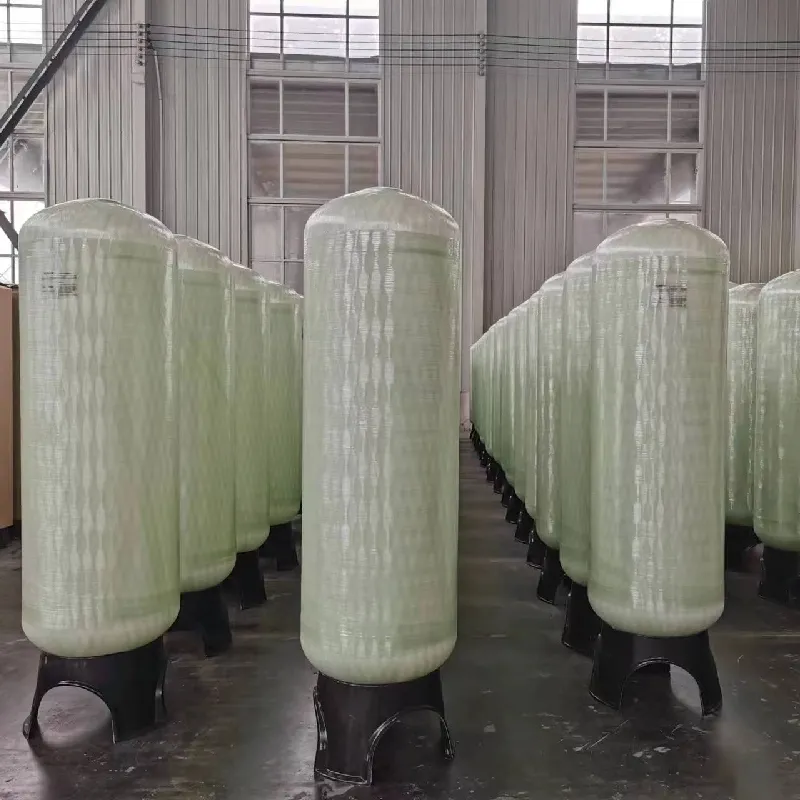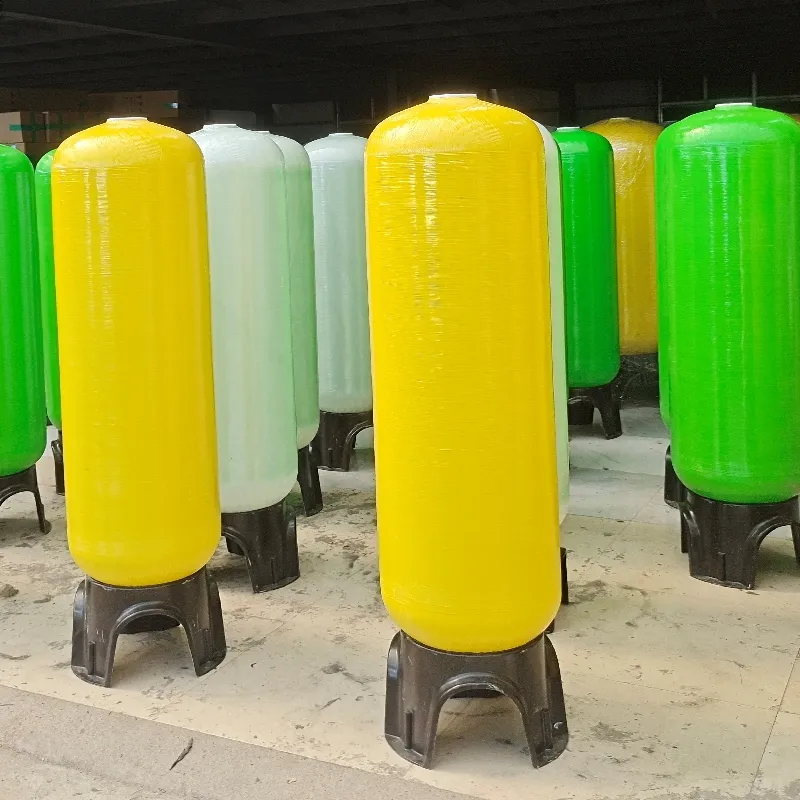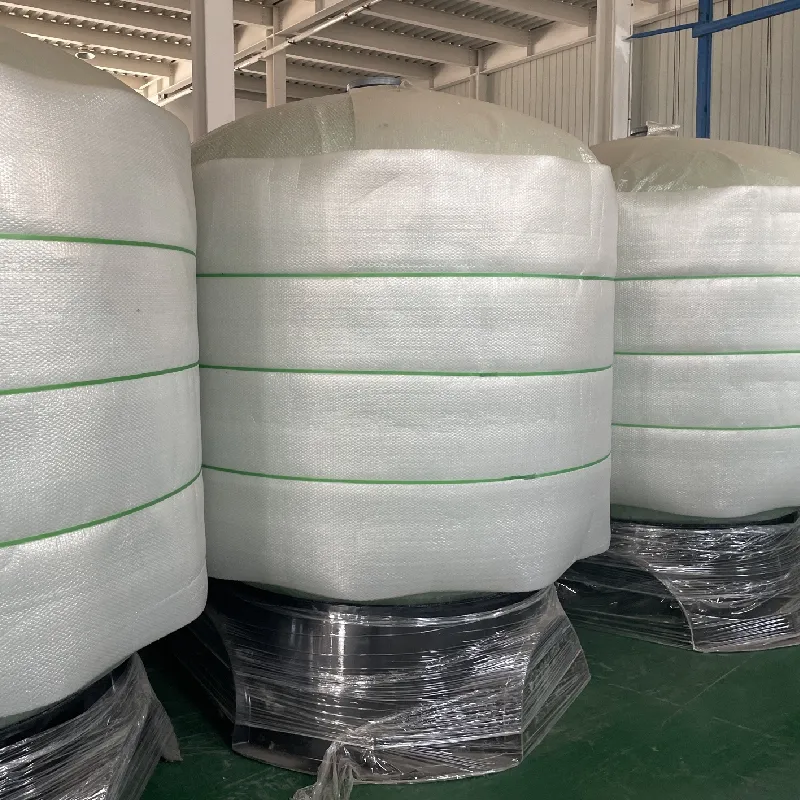loading...
- No. 9, Xingyuan South Street, Dongwaihuan Road, Zaoqiang County, Hengshui, Hebei, China
- admin@zjcomposites.com
- +86 15097380338
- Welcome to visit our website!
High-Performance FRP Vessels for Water Treatment & Storage
The Strategic Role of FRP Vessels in Modern Industrial Applications
In the evolving landscape of B2B industrial infrastructure, the demand for highly durable, corrosion-resistant, and cost-effective storage and processing solutions is paramount. Fiber Reinforced Plastic (FRP) vessels have emerged as a critical component, offering superior performance characteristics compared to traditional metallic alternatives. These advanced composite structures are engineered to withstand aggressive chemical environments, high pressures, and varying temperatures, making them indispensable across a multitude of sectors. The market for FRP vessels is experiencing robust growth, driven by increasing regulatory demands for material safety, a rising emphasis on sustainable infrastructure, and the continuous innovation in composite material science.
Industry trends indicate a significant shift towards materials that offer extended service life and reduced maintenance, directly impacting the total cost of ownership. The intrinsic benefits of composites, such as their high strength-to-weight ratio and exceptional corrosion resistance, are key factors influencing this adoption. Furthermore, the global focus on water scarcity and quality has amplified the necessity for reliable and efficient water treatment systems, where FRP vessels play a foundational role. The optimization of manufacturing processes has also led to a more competitive frp vessel price, making these sophisticated solutions accessible to a broader range of industrial clients.
Manufacturing Excellence: The Process Behind High-Performance FRP Vessels
The production of high-quality frp vessels is a sophisticated multi-stage process, demanding precision engineering and rigorous quality control. This process ensures that each vessel meets stringent performance criteria for its intended application, from chemical storage to advanced water purification.
Core Materials and Structural Integrity
The foundation of an FRP vessel lies in its composite materials. Typically, these include high-performance resins (e.g., isophthalic polyester, vinylester, or epoxy) combined with reinforcing fibers, predominantly fiberglass. For specific applications, such as those involving potable water or food-grade processes, an inner liner is crucial. Our "Composite Food Grade Pressure Vessel With HDPE Inner For Water Filter" exemplifies this, utilizing a High-Density Polyethylene (HDPE) inner liner. This liner provides an impermeable, smooth, and chemically inert barrier, preventing contamination and ensuring compliance with strict health and safety standards like FDA regulations. The outer composite layers provide the structural strength and pressure integrity.
Detailed Manufacturing Process Flow
Schematic Steps:
- 1. Liner Preparation: An impermeable inner liner (e.g., HDPE, as used in our food-grade vessels) is formed, often by blow molding or rotomolding. This liner is critical for chemical resistance and maintaining the purity of the stored media.
- 2. Filament Winding: This is the primary structural fabrication method. Continuous strands of fiberglass roving, impregnated with thermosetting resin, are wound onto the prepared liner using precisely controlled machinery. This process builds up layers, creating a strong, uniform composite wall capable of handling design pressures.
- 3. Curing: The wound vessel is then subjected to a controlled curing process (typically oven baking) where the resin polymerizes and hardens, bonding the fibers and forming a rigid, monolithic structure. This step is crucial for achieving the desired mechanical properties.
- 4. Post-Curing/Finishing: After the initial cure, the vessel may undergo post-curing to optimize resin properties. Subsequent steps include trimming, fitting of top and bottom opening ports, and external surface finishing.
- 5. Quality Control & Testing: Each vessel undergoes rigorous testing. This includes hydrostatic pressure testing to verify structural integrity, visual inspections, dimensional checks, and material certifications. Compliance with international standards such as ISO 9001, ASME Section X, and FDA regulations (for food-grade applications) is meticulously verified.
The average service life of a well-manufactured frp vessel typically ranges from 15 to 25+ years, significantly outperforming many traditional materials in corrosive environments. Target industries include petrochemical, metallurgy, power generation, and crucially, water supply & drainage, food & beverage, and pharmaceutical sectors due to the enhanced corrosion resistance and energy-saving benefits.

Figure 1: Advanced filament winding process for FRP vessel construction.
Technical Specifications and Performance Parameters
Understanding the technical specifications of frp vessels is crucial for selecting the right solution for specific industrial needs. Key parameters define a vessel's suitability for pressure, volume, temperature, and chemical compatibility. Our Composite Food Grade Pressure Vessel with HDPE Inner, designed for water filter applications, demonstrates a balance of robust engineering and material integrity.
Key Operational Parameters
- Operating Pressure: Typically rated for pressures up to 150 psi (10 bar), suitable for most water treatment and light industrial applications.
- Operating Temperature: Generally capable of handling temperatures from 1°C to 49°C (34°F to 120°F). Higher temperature resins are available for specialized needs.
- Volume Capacity: Available in a wide range of volumes, from compact residential units to large industrial tanks exceeding several thousand liters.
- Port Sizes: Standardized top and bottom opening ports (e.g., 2.5", 4", 6" NPT or BSP) to facilitate easy integration with existing piping and internal distribution systems.
- Material Composition: Fiberglass reinforced composite shell with various resin types, and specific liners (e.g., HDPE, ABS, PE) tailored for chemical compatibility and safety.
Typical Product Specification Table: Composite Food Grade Pressure Vessel
Below are representative specifications for our food-grade FRP vessels, ideal for frp vessel for water treatment applications.
| Parameter | Standard Range (Typical) | Specific Detail (HDPE Liner Model) |
|---|---|---|
| Vessel Diameter | 6" to 63" (152mm to 1600mm) | 8", 10", 12", 14", 16", 18", 21", 24", 30", 36" |
| Height | 17" to 86" (432mm to 2184mm) | Dependent on specific model (e.g., 44", 54", 62") |
| Working Pressure | Up to 150 psi (10 bar) | 150 psi (10.3 bar) |
| Burst Pressure | 600 psi (41 bar) minimum | 600 psi (41.4 bar) |
| Working Temperature | 1°C - 49°C (34°F - 120°F) | 1°C - 49°C |
| Liner Material | PE, ABS, HDPE | HDPE (Food Grade, FDA Compliant) |
| Top Opening | 2.5" NPSM, 4" NPT, 6" Flange | 2.5" NPSM or 4" NPSM |
| Certification | ISO 9001, CE, NSF, FDA | NSF Certified, FDA Compliant |

Figure 2: Interior view highlighting the HDPE liner in a food-grade FRP vessel.
Unmatched Technical Advantages of FRP Composite Vessels
The adoption of frp vessels in challenging industrial environments is predominantly driven by their distinctive technical advantages over conventional metallic vessels. These advantages translate directly into significant operational efficiencies and cost savings for B2B enterprises.
- Superior Corrosion Resistance: Unlike steel, FRP materials do not rust or corrode when exposed to harsh chemicals, acids, alkalis, or saline environments. This makes them ideal for chemical storage, wastewater treatment, and marine applications, drastically reducing maintenance and replacement costs. The HDPE inner liner further enhances chemical inertness for specific media.
- Exceptional Strength-to-Weight Ratio: FRP vessels are significantly lighter than their steel counterparts, often by 50-70%. This facilitates easier and more cost-effective transportation, installation, and relocation, especially in remote or difficult-to-access sites. Despite being lightweight, they maintain high structural integrity and pressure ratings.
- Long Service Life: Due to their inherent resistance to corrosion, fatigue, and environmental degradation, FRP vessels typically offer a service life of 15 to 25 years or more, often surpassing metallic vessels in challenging conditions. This extended lifespan contributes to a lower total cost of ownership.
- Low Maintenance Requirements: The durable, non-corrosive nature of FRP eliminates the need for painting, cathodic protection, or frequent inspections for rust and pitting, common with steel tanks. This reduces downtime and operational expenditures.
- Energy Efficiency: FRP is a naturally insulating material, possessing a much lower thermal conductivity than steel. This can lead to energy savings in applications where temperature regulation of the stored medium is critical, reducing heating or cooling costs.
- Design Flexibility: The filament winding process allows for the creation of vessels in various sizes, shapes, and custom configurations, including integrated fittings and specialized linings, tailored to unique process requirements.
Versatile Application Scenarios and Proven Case Studies
The versatility and robust performance of frp vessels enable their deployment across a broad spectrum of industrial applications. From critical water treatment infrastructure to specialized chemical processing, their benefits are widely recognized.
Key Application Areas
- Water Treatment & Purification: Indispensable as filter vessels for media filtration, activated carbon filtration, water softening, deionization, reverse osmosis (RO) pre-treatment, and ultrafiltration systems. The food-grade HDPE liner is crucial for potable water and bottled water production, establishing them as the premier frp vessel for water treatment.
- Chemical Processing: Storage and processing of corrosive chemicals such as acids (hydrochloric, sulfuric), alkalis, and various industrial solvents.
- Food & Beverage Industry: Used for the storage of potable water, processing juices, wines, and other food-grade liquids where hygiene and non-contaminating materials are critical.
- Pharmaceuticals: Essential for high-purity water systems, laboratory applications, and the storage of process ingredients where material inertness is paramount.
- Oil & Gas: Though less common for high-pressure upstream, they find use in downstream applications like produced water treatment and chemical storage for field operations.
Application Case Studies
Case Study 1: Municipal Water Treatment Plant Upgrade
A major municipal water treatment plant in a coastal region faced persistent issues with corrosion in its steel filter vessels, leading to frequent maintenance and premature replacements. After consulting with our engineering team, they opted to replace 30 existing steel pressure filters with large-scale frp vessels with specialized internal distributors. The transition resulted in a 70% reduction in annual maintenance costs associated with corrosion, a 15% improvement in filtration efficiency due to superior internal flow dynamics, and an estimated 20-year extended service life compared to their previous steel vessels.
Client Feedback: "The switch to FRP technology was a strategic decision that immediately enhanced our operational reliability and significantly cut down our lifecycle costs. The chemical resistance is unparalleled."
Case Study 2: Beverage Production Facility's Potable Water System
A leading beverage producer required an upgrade to its potable water filtration system to ensure absolute purity and compliance with stringent food safety standards. They implemented our Composite Food Grade Pressure Vessel with HDPE inner liners for their multi-stage filtration process. The HDPE liner ensured no leaching or contamination, while the robust FRP exterior provided the necessary pressure integrity. This upgrade eliminated concerns about metallic contamination, improved product consistency, and provided peace of mind regarding regulatory compliance.
Client Feedback: "The food-grade FRP vessels were essential for our quality assurance. The design and material choice were perfectly suited for our sensitive production environment, offering reliability we couldn't achieve with other materials."
Vendor Comparison and Customized Solutions
When sourcing frp vessels, B2B decision-makers evaluate vendors based on a comprehensive set of criteria including product quality, certifications, customization capabilities, and after-sales support. A strategic partnership with an experienced manufacturer is key to ensuring optimal performance and long-term value.
Key Factors in Vendor Selection
- Quality & Certifications: Look for manufacturers with ISO 9001 certification, ASME Section X compliance, and specific product certifications like NSF for water treatment or FDA for food-grade applications.
- Experience & Expertise: Years of service, industry-specific knowledge, and a track record of successful projects in relevant sectors.
- Customization Capabilities: The ability to tailor vessel dimensions, port configurations, liner materials, pressure ratings, and accessory integration to precise project specifications.
- Lead Time & Logistics: Efficiency in production and reliable global logistics for timely delivery.
- After-Sales Support & Warranty: Comprehensive warranty programs, technical support, and availability of spare parts.
- Competitive frp vessel price: Balancing initial cost with long-term value, considering durability and maintenance savings.
FRP Vessels vs. Steel Vessels: A Comparative Analysis
This table highlights key differences, emphasizing why FRP is often the superior choice for specific applications.
| Feature | FRP Vessels | Carbon Steel Vessels |
|---|---|---|
| Corrosion Resistance | Excellent against wide range of chemicals, no rust. | Poor, requires coatings or cathodic protection. |
| Weight | Lightweight (50-70% less than steel). | Heavy. |
| Installation | Easier, lower transport & rigging costs. | Requires heavy lifting equipment, higher costs. |
| Maintenance | Very low, no painting, internal linings often permanent. | High, requires periodic painting, lining repair, rust treatment. |
| Service Life | Long (15-25+ years) in appropriate conditions. | Variable, significantly reduced by corrosion if not maintained. |
| Insulation Properties | Good thermal insulator, reduces energy costs. | Poor, requires external insulation for temperature control. |
| Initial frp vessel price | Generally competitive, especially considering longevity. | Potentially lower for basic models, but higher lifecycle costs. |

Figure 3: Range of FRP vessels showcasing varied sizes and configurations.
Trustworthiness and Customer Support
In the B2B sector, trust is built not only on product quality but also on the reliability of the manufacturing partner. Our commitment to expertise, authoritativeness, and trustworthiness is reflected in our rigorous standards and comprehensive customer support.
Authoritative Standards and Certifications
Our manufacturing processes and products, including our frp vessel for water treatment with HDPE liner, adhere to the highest international standards. We are ISO 9001 certified, ensuring consistent quality management systems. Our food-grade vessels meet FDA compliance standards and are NSF certified, guaranteeing safety and suitability for potable water and food contact applications. These certifications are a testament to our unwavering commitment to quality and regulatory compliance.
Frequently Asked Questions (FAQ)
Q1: What is the typical lifespan of an FRP vessel?
A1: With proper design, installation, and operation, FRP vessels can have a service life of 15 to 25 years or even longer, significantly surpassing many traditional metallic vessels, especially in corrosive environments.
Q2: How do FRP vessels compare to steel vessels in terms of cost?
A2: While the initial frp vessel price can sometimes be comparable to or slightly higher than basic steel vessels, the long-term cost of ownership for FRP is typically lower. This is due to reduced maintenance, longer service life, lower installation costs (lighter weight), and superior corrosion resistance, eliminating expensive protective coatings and frequent replacements.
Q3: Are FRP vessels suitable for all types of chemicals?
A3: FRP offers excellent resistance to a wide range of chemicals. However, chemical compatibility depends on the specific resin system and liner material used. It is crucial to consult our technical team to ensure the selected FRP vessel is compatible with your specific chemical media, concentration, and temperature.
Q4: What maintenance is required for FRP vessels?
A4: FRP vessels require significantly less maintenance than steel vessels. Regular visual inspections for external damage, proper operation within specified pressure and temperature limits, and ensuring proper internal distribution systems (for filter vessels) are typically sufficient. They do not require painting or cathodic protection.
Q5: How can I select the right FRP vessel for my application?
A5: Selecting the correct vessel involves considering several factors: fluid type, operating temperature and pressure, required volume, chemical compatibility, regulatory requirements (e.g., FDA for food contact), and desired port configurations. Our technical sales engineers are available to provide expert guidance and assist in specifying the optimal FRP solution.
Lead Time, Warranty, and After-Sales Support
We understand the importance of timely delivery for industrial projects. Our standard lead times for common frp vessels range from 2-4 weeks, with expedited options available for urgent requirements. Custom-engineered solutions may require longer, depending on complexity. We stand by the quality of our products with a comprehensive warranty program, typically offering 5 years on vessel integrity against manufacturing defects. Beyond the sale, our dedicated customer support team provides technical assistance, troubleshooting guides, spare parts availability, and expert advice to ensure the sustained optimal performance of your FRP vessels.
Conclusion
The continuous evolution of industrial processes demands materials that offer unparalleled performance, reliability, and economic viability. FRP vessels unequivocally meet these demands, providing superior corrosion resistance, lighter weight, extended service life, and lower total cost of ownership compared to traditional materials. Their critical role in water treatment, chemical processing, and food & beverage industries underscores their indispensable nature. As industries strive for greater efficiency, sustainability, and safety, FRP technology will remain at the forefront of advanced material solutions.
References
- ISO 9001:2015 Quality management systems — Requirements. International Organization for Standardization.
- ASME Boiler and Pressure Vessel Code, Section X: Fiber-Reinforced Plastic Pressure Vessels. The American Society of Mechanical Engineers.
- U.S. Food & Drug Administration (FDA) CFR Title 21 - Food and Drugs, specifically relevant sections for food contact materials.
- NSF/ANSI Standard 61: Drinking Water System Components – Health Effects. NSF International.
- "Advanced Composite Materials and Their Applications" - Journal of Composite Materials.
- "Corrosion Resistance of FRP Composites in Chemical Industries" - NACE International.
-
Revolutionizing Industrial Safety with ZJ Composites' Mini Mesh GratingNewsNov.14,2025
-
Premium FRP Profiles and FRP Grating Revolution for Global WholesalersNewsNov.14,2025
-
Ultimate Strength with ZJ Composites FRP Profiles for Wholesale SuccessNewsNov.14,2025
-
ZJ Composites Covered Grating – The Durable Flooring Solution for Smarter Industrial SpacesNewsNov.14,2025
-
Mini Mesh Grating Enhancing Strength and Style in Every ProjectNewsNov.14,2025
-
FRP Pressure Vessels by ZJ CompositesNewsNov.14,2025
-
Transforming Industrial Spaces with Advanced Frp GratingNewsNov.11,2025
